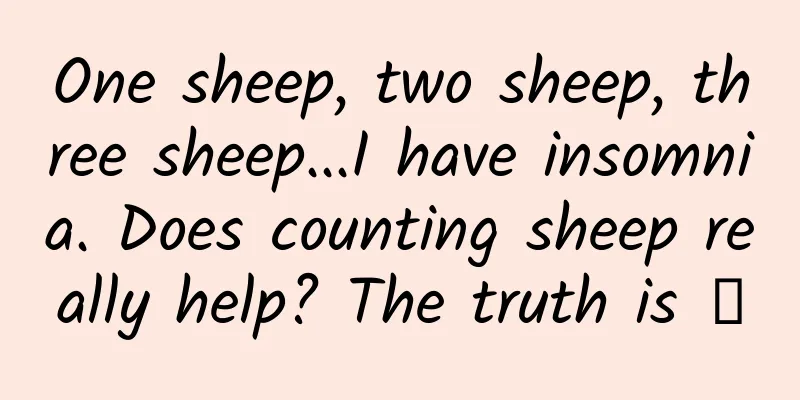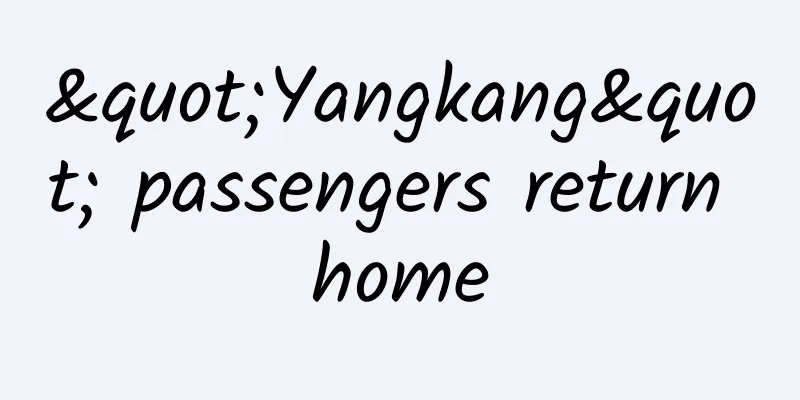One sheep, two sheep, three sheep...I have insomnia. Does counting sheep really help? The truth is →

|
“When you can’t sleep, count sheep and you’ll fall asleep quickly.” The English pronunciation of "sheep" is very close to "sleep", so when counting sheep, you will think of sleeping, which has a certain suggestive effect, while at the same time avoiding the psychological pressure caused by directly ordering yourself to sleep. Rumor Analysis This approach doesn't work. In Chinese, "sheep" and "sleep" cannot be associated together. This method not only cannot help you sleep, but may also affect your ability to fall asleep. This is because when you count sheep, you will unconsciously focus on the number of sheep, and your brain will be in an excited state, causing you to become more awake the more you count. Does counting sheep really help you fall asleep faster? There are such scenes in many cartoons, where the character mutters "one sheep, two sheep, three sheep...", and then his eyelids begin to droop and he starts snoring. However, in real life, does counting sheep really help you fall asleep? There is no scientific research to prove Counting sheep can help you fall asleep So far, there has been no scientific research on whether counting sheep helps you sleep, but a study published in 2002 by Allison Harvey, a psychologist at the University of Oxford, can provide some reference. In this study, Harvey divided 41 volunteers with insomnia into three groups: Image distraction group: Before going to bed, they imagine a scene that they find interesting and attractive, but also pleasant and relaxing to distract themselves, but avoid choosing scenes that are more stimulating and easy to wake up the brain (such as an exciting car race). Most members of this group choose to imagine a vacation, a summer afternoon or some natural scenes; Simple distraction group: Do some simple distraction things before going to bed to avoid worries and overactive thoughts before going to bed. Because they can freely choose the distraction method, in this group, 6 people recalled what happened today, 2 people counted sheep, 2 people meditated, 1 person recalled a favorite tune in their mind, 2 people chose to skip when unpleasant thoughts appeared, and 1 person focused on physical relaxation; No strategy group: No requirements were given and they could fall asleep in any way. All volunteers were asked to keep a sleep diary, self-assess the time it took to fall asleep at night, and record their thoughts before falling asleep (scored on a scale of 0 to 10, with 0 representing "no thoughts or worries in my mind" and 10 representing "my mind is full of thoughts and worries") and emotional state (scored on a scale of 0 to 10, with 0 representing "no pain or discomfort" and 10 representing "extreme pain and discomfort"). The study found that the image distraction group had the fastest average speed of falling asleep, and their sleep onset time was significantly shorter than before participating in the experiment; in addition, this group's emotional state was significantly better than the other two groups. So does using distraction strategies such as counting sheep have the same effect? Unfortunately, although this group took a slightly shorter time to fall asleep than the group without a strategy, there was no improvement compared to their data before participating in the experiment. Therefore, it cannot be proved that distraction behaviors such as counting sheep help to fall asleep. Left bar graph: time required to fall asleep; right bar graph: deviation score = time required to fall asleep compared to time required before the experiment - time required to fall asleep during the experiment. (Black represents the image distraction group; light gray represents the simple distraction group; dark gray represents the no strategy group.) | Source: Literature 7 Twenty years after the study was published, Harvey told CNN about his experience treating insomniacs: “ Things like counting sheep don’t usually work . We give people a list of options because everyone is different and there’s not always one way to solve the problem.” Sydney sleep psychologist Dianne Richards also advises against counting sheep to help you fall asleep, because for some people, the counting task can put stress on the brain . “Trying to remember numbers can be tiresome for some people,” she says, “and imagining sheep jumping over fences may be too stimulating for some people. If you just imagine the sheep standing still and feeling the softness of their wool up close, that might be better. Ultimately, the task you choose has to work for you and has to be something you find enjoyable and relaxing.” Where does the saying of counting sheep when you can’t sleep come from? Since there has been no conclusive scientific evidence to support that counting sheep can help you fall asleep, where did this long-standing sleep remedy come from? The prevailing view is that the custom of counting sheep may have originated as a simple and practical custom in medieval England. In that era, shepherds needed to count their sheep at night after a day of grazing. This was not only to ensure that all the sheep were safely back in the pen, but also to confirm the integrity of the flock by counting the sheep, which was the end of the day's work for the shepherd. When night falls, only after they have completed the task of counting sheep and confirmed that the number of sheep is correct, can they fall asleep contentedly. This behavior of counting sheep at night, due to its simplicity, rhythmic and repetitive characteristics, probably helped the shepherds relax after a long day and eventually became a ritual for falling asleep. As time goes by, counting sheep has gradually spread as a cultural tradition and sleeping technique. Copyright images in the gallery. Reprinting and using them may lead to copyright disputes. Some people also believe that the pronunciations of "sheep" and "sleep" are very similar. This auditory similarity may invisibly add a layer of psychological suggestion to the saying that "counting sheep can help you sleep", making it easier for people to associate this behavior with the state of seeking sleep. However, for people who speak other languages, counting sheep does not have the same suggestive power. As people often joke, for Chinese people, if they want to suggest going to bed, they should not count "sheep" but "dumplings", which are more similar to "sleep". Useful sleep aids Since there is no clear scientific basis for counting sheep to help you sleep, are there any scientific methods to help you sleep? Harvey offers several approaches worth trying: 1. Imagine a pleasant and engaging environment, and try to involve multiple senses. For example, you can try to make your imagination as vivid as possible, asking yourself what you see, hear, smell, and even taste. 2. Think of three things in your life that you are grateful for, and say them to yourself before going to bed. 3. Review the little joys of the day, immerse yourself in those good feelings, and encourage yourself to fall asleep. In addition, Rebecca Robbins, a sleep and circadian rhythm disorder researcher at Harvard University, recommends using the 4-7-8 breathing control method to help clear your mind of distracting thoughts and improve sleep. Empty the lungs with air Breathe in quietly through your nose for 4 seconds Hold your breath for 7 seconds Exhale forcefully through your mouth, pursing your lips to make a whooshing sound for 8 seconds Repeat this cycle up to 4 times But as Harvey and Richards say, everyone's physical and mental conditions are different, and it's important to find a method that works for you. Whether it's through imagery, gratitude review, or other breathing techniques, as long as you can really relax, it's a good method. Looking in the mirror of rumors Such rumors often lack scientific basis and are based on cultural traditions or personal experience. In the field of medicine and scientific research, there is no evidence that counting sheep can cure insomnia. Because rumors are psychologically suggestive and misleading, they can often spread quickly. References [1]https://www.rd.com/article/counting-sheep/ [2]Illustrations of Political Economy (3rd ed) in 9 vols. (London: Charles Fox, 1832). [3]Alfonso, Pedro; Alfonsi, Petrus (January 1977). Eberhard Hermes (ed.). The Disciplina Clericalis of Petrus Alfonsi. Translated by Eberhard Hermes, PR Quarrie. ISBN 9780520027046. [4] Don Quixote, translated by Yang Jiang, People’s Literature Publishing House [5]https://en.wikipedia.org/wiki/Counting_sheep [6]https://www.verywellhealth.com/does-counting-sheep-actually-put-a-person-to-sleep-2224296#:~:text=In%20most%20versions%20of%20the,the%20visualization%20helps%20people%20sleep. https://piyao..cn/h5/rumordetail?id=bEOx [7]Harvey AG, Payne S. The management of unwanted pre-sleep thoughts in insomnia: distraction with imagery versus general distraction. Behavior Research and Therapy. 2002;40(3):267-277 [8]https://www.cnn.com/2024/03/24/health/counting-sheep-for-sleep-explained-wellness/index.html [9]Harvey, Allison G., and Suzanna Payne. 2002. “The management of unwanted pre-sleep thoughts in insomnia: distraction with imagery versus general distraction.” Behavior Research and Therapy. 40 (3): 267-277.[10]https://www.abc.net.au/everyday/does-counting-sheep-help-you-get-to-sleep/11219660 [11]Vierra J, Boonla O, Prasertsri P. Effects of sleep deprivation and 4-7-8 breathing control on heart rate variability, blood pressure, blood glucose, and endothelial function in healthy young adults. Physiol Rep. 2022 Jul;10(13):e15389. doi: 10.14814/phy2.15389. PMID: 35822447; PMCID: PMC9277512. [12]https://www.thenewdaily.com.au/life/2023/07/08/want-to-fall-asleep-in-two-minutes [13]https://www.cnn.com/2022/09/16/health/4-7-8-breathing-technique-relaxing-wellness/index.html Planning and production Author: Dr. Hardy, Neurobiology Reviewer: Li Jingjing, Professor and Chief Physician, Department of Neurology, Beijing Tiantan Hospital Planning丨Wang Mengru Editor: Wang Mengru Proofread by Xu Lailinlin The cover image and the images in this article are from the copyright library Reprinting may lead to copyright disputes |
<<: Who would have thought that “greasy” fruits could become a source of nutritional “clear water”?
>>: Great! Scientists have invented a new fabric that automatically cools you down when you wear it
Recommend
Lily SEO Training: What are the aspects of search engine friendliness?
First: Directory Structure A clear and concise di...
Is your product suitable for WeChat mini program? You need this product logic analysis!
On the evening of September 21, WeChat announced ...
Summary of common problems in the App Store listing review process
1. Introduction to iOS APP Listing Process Apply ...
Is it normal for workers to be tired? Don’t take being tired lightly, this is how these diseases come about!
Ms. Jiang, 30 years old, is a white-collar worker...
Google AdWords detailed tutorial from account registration to advertising
If you want to advertise on your own cross-border...
Why don’t the British use Tannoy and KEF speakers anymore? What’s the reason?
Some audiophiles asked why they didn't see Ta...
You can earn over 10,000 yuan a month by operating the knowledge payment CPS distribution project with the official account
People often add me on WeChat and ask what good m...
What knowledge is needed to operate Tik Tok?
Douyin in the south and Kuaishou in the north are...
Writing a JavaScript framework: better timed execution than setTimeout
[[177395]] This is the second chapter of the seri...
What is the Hammer smartphone doing with less than 1,000 units shipped on the first day?
What is the Hammer smartphone doing with less tha...
It can save lives at critical moments, and disaster prevention emergency kits also have national standards!
It can save lives at critical moments, and disast...
Terrible Pluto: It is not unfair to be kicked out of the ranks of planets in the solar system
Humans love to give names to celestial bodies, an...
80% of online education institutions are learning how to operate private domains
Perhaps some people are still unfamiliar with chi...
User behavior analysis of user operations!
From traffic marketing to data-driven, the refine...
These 4 types of foods don’t taste salty, but they have such high sodium content? !
If your blood pressure is high, eat less salt - t...









